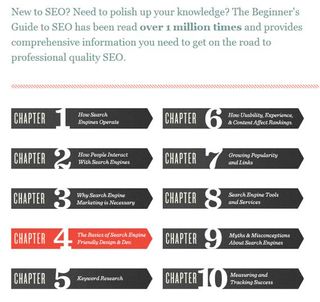10 things you need to know about Google Panda and Penguin
Tom Gregan of SEO specialists Brandfluent Digital explains what the latest updates to Google's algorithm mean for SEO and how you can use this knowledge to boost your websites' rankings
Google’s recent Penguin and Panda algorithm updates have been big news, and it’s widely agreed that they’ve improved the quality of search results substantially. But how do make sure your site doesn't lose out?
As SEO professionals, we’d like to share with the web designer community what we think Google is now looking for. Hopefully this can help both sides work together more harmoniously to make quality, high-ranking websites.
1. What we know
At its core, the Panda update is about signals pertinent to relevance and a site’s ability to indicate that it belongs high in results. Google is taking time to assess signals such as:
- The amount of content above the fold
- The bounce rate for a page
- The click-through rate of the page
- The number of clicks a page gets in results
… and more, always intent on evaluating whether a page is proving itself as providing relevant content for the search in question.
Importantly, no longer does it seem that Google simply demotes poor quality pages. Instead, it is willing to demote the entire domain, simply because a few pages are letting the site down.
Penguin, meanwhile, has brought into focus “over-optimisation”, a term coined by Google’s distinguished engineer and head of webspam, Matt Cutts. While the majority of the signals introduced by Penguin are related to offsite work (ie, poor quality links being built back to the domain) there are a few considerations which are specifically relevant to design practices.
The first thing I always recommend when blue-printing a build for developers is an appreciation that content must be given paramount importance. Landing pages, the site’s homepage, product pages and all other pages you want to appear in results must endeavour to include not only a significant amount of text, but also a variety of content.
Get the Creative Bloq Newsletter
Daily design news, reviews, how-tos and more, as picked by the editors.
Remember that while look and feel help to make a site user trust and navigate further throughout the build, it is content alone which gets them seen in search.
2. Complement main images
Having content feature above the fold (as opposed to ads) is at present believed to be a positive Panda signal. As images are often a large part of design, we recommend complementing main images which take up a large amount of above-the-fold real estate with concise, yet on-topic HTML text, neatly nested in an attractive textbox.
For bonus points, each box of text should include a <h> tag to indicate the primary key term which the following text is relevant to.

We further recommend that when trying to incorporate text in to your design, go and pick up an informative publication (such as the .net print magazine) and flick through to see how they combine large amounts of text with imagery and photography.
These publications generally have text as their primary concern and images and photos work to break up the monotony, which is close to how SEO friendly design ought to work.
3. Considered content
Important pages throughout the build ought to be afforded a substantial amount of considered content, which ideally would ensure a decent text: code ratio (I usually aim for 1:5). We believe that keyword density is of lesser importance than having a variety of relevant key terms. Striving to incorporate terms you expected to come up in a discussion about the main topic of the page is a less suspect and more search friendly approach to generating content.
Whilst it’s not always easy to make content about some services/products a riveting read, using images, lists, embedded videos and quotes can help to maintain and develop relevance.
4. Plagiarism and duplication
From experience, the majority of plagiarised text comes from external profiles that the business itself has set up. In order to save time, employees and site owners will lift text from their site in order to quickly fill in details.
This practice will potentially earn your client a run in with Panda, which could mean being anchored down in results. We recommend ensuring that all content can be adapted via the site’s CMS, which will earn you a hat-tip from any SEO agency which takes on the domain.
While you cannot stop laziness in the client, you can provide a means to adapt the content on the site, permitting the ability to change the content and side-step any form of punishment for duplicate content.
5. Click-through rate
We now believe that the number of pages a site user clicks through before leaving the domain, or returning to the results page, is in itself an indication of relevance.
A domain that has a high number of clicks-through to other internal pages is believed by Google to be more relevant and therefore worthy of high positions.
We recommend putting clickworthy information into a series and incentivising clicking-through, which in practicality means requiring clickthrough to get the full story/information. This works particularly well on the homepage of the domain, where content can be written to require a click-through in order to completely read all the relevant information.

6. Dwell time
While dwell time is known to be an established quality signal for Google’s PPC services, we believe that currently a similar consideration has been included in Google’s Panda algorithm.
In a nutshell, dwell time (and specifically dwell time relevant to organic search) is a signal that averages the amount of time spent on a page after click-through in results. The longer the searcher spends on site, the more relevant that site appears to Google.
7. Dwell techniques
As you probably will have already guessed, dwell techniques are a growing collection of ways in which to increase dwell time. Typically, we employ dwell techniques on main category, sub-category, article pages/posts, education pages and other pages which frequently have users click on, extract information, then leave.
Considering that bounce rate is now a significant signal in Panda, dwell techniques are beginning to make their way in to SEO site design recommendations.
In a nutshell, dwell techniques mean creating and utilising content on category, sub-category and other important pages throughout the build, which encourage users to read over or interact with the page and refrain from bouncing.
Explaining a brand’s USP using a slideshow or 30-second video clip makes the information easily digestible and keeps them engaged for the time it takes to reach the end. From a search perspective, this content has resulted in a longer time on site, which means a better signal to Google.

8. Spelling and grammar
Spelling and grammar mistakes on your site are frankly unacceptable, so it’s definitely worth proof-reading any copy thoroughly. Using a spellchecking tool is a must, while services such as checkdog.com and Net Mechanic provide free and paid-for services to assess your entire build for mistakes which may be lowering Google’s evaluation of your domain.
It should be mentioned that we’ve never had a client that has significantly suffered a fall in rankings due to poor spelling and grammar, but from a trust, search and UX perspective it’s an obvious weakness.
9. Anchor text
We recommend assuring that any accrediting footer links throughout sites you have built use brand name anchor text and not terms you wish to appear for.
Key-term anchor text such as: “web design”, “branding and web development” and “web branding” should be replaced with the company’s brand name. Having several thousand links from one domain, all with the same anchor text, is likely to incur the wrath of penguin.
10. Content embeds
When providing an ‘embed this link/content’ frame into a build, we are currently recommending that all anchor text used strives to include the company’s brand name and change for each new piece of content.
While this is not a big problem for smaller brands with lesser traffic, builds that encourage a lot of backlinks or projects that are expected to attract a lot of links ought to ensure that all links back are branded and not identical.

Conclusion
Ultimately, we have found that it’s easy to avoid being demoted due to Google’s Panda and Penguin update, provided all stakeholders in the site recognise that search loves content.
Essentially, investing in content from a design perspective will inevitably mean the corner-cutting short-cuts which are being targeted primarily by Panda and indirectly through Penguin, will not anchor down your clients.
Here is some more useful reading:
www.seomoz.org/blog/whiteboard-on-googles-penguin-update
www.webpronews.com/google-penguin-update-recovery-advice-from-bing-2012-05
www.seomoz.org/blog/how-googles-panda-update-changed-seo-best-practices-forever-whiteboard-friday
searchengineland.com/penguin-update-recovery-tips-advice-119650
searchengineland.com/5-new-tactics-for-seo-post-panda-73982
searchengineland.com/yet-more-tips-for-diagnosing-fixing-panda-problems-92082
"Five Emperor Penguins" image from Bigstock.

Thank you for reading 5 articles this month* Join now for unlimited access
Enjoy your first month for just £1 / $1 / €1
*Read 5 free articles per month without a subscription

Join now for unlimited access
Try first month for just £1 / $1 / €1
The Creative Bloq team is made up of a group of design fans, and has changed and evolved since Creative Bloq began back in 2012. The current website team consists of eight full-time members of staff: Editor Georgia Coggan, Deputy Editor Rosie Hilder, Ecommerce Editor Beren Neale, Senior News Editor Daniel Piper, Editor, Digital Art and 3D Ian Dean, Tech Reviews Editor Erlingur Einarsson and Ecommerce Writer Beth Nicholls and Staff Writer Natalie Fear, as well as a roster of freelancers from around the world. The 3D World and ImagineFX magazine teams also pitch in, ensuring that content from 3D World and ImagineFX is represented on Creative Bloq.
